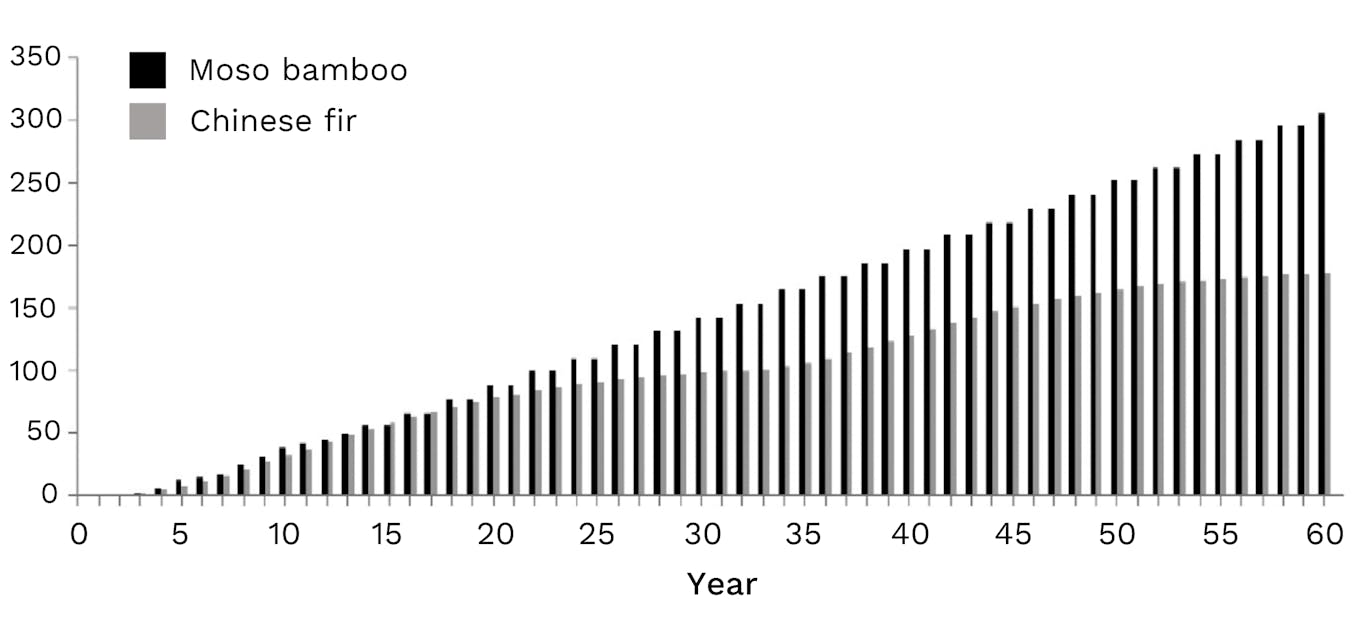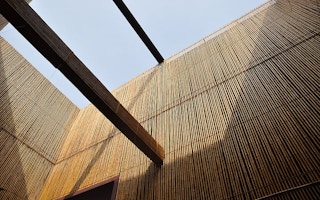They are synonymous with the giant panda, and a ubiquitous part of life and culture across much of the south. China’s bamboo forests – all 6.8 million hectares of them – could also play an outsized role in the country’s plans to check climate change.
Fast-growing, versatile and able to thrive on sloping, degraded soils, giant bamboos have long been considered a valuable source of income – sometimes called “poor man’s timber” – as well as an important tool for stabilising slopes and preventing soil erosion.
More recently, bamboo has gained attention alongside tree-planting for its potential role in removing large amounts of carbon dioxide from the atmosphere, which would contribute to keeping global warming below 1.5C.
A fast-growing super grass
Bamboo can help China curb greenhouse gas emissions in two ways: through its forests, which act as giant carbon sinks, and its durable products, which store carbon and can serve as a replacement for timber, concrete and steel.
The secret to bamboo’s success is that it’s a grass, not a tree. It grows fast and accumulates carbon quickly, with an extensive root system that survives annual harvesting. This makes bamboo a fast-regenerating resource, which can supply more biomass than both natural and planted forests.
Once mature, bamboo poles can be selectively harvested every year, and used to make a wide range of durable products, which lock in carbon for the duration of a product’s lifespan.
This high yield makes bamboo a surprisingly effective carbon sink and important nature-based approach to mitigating global warming. One study estimates that a one-hectare plantation of bamboo and its products could store 306 tonnes of carbon over a 60-year period compared with 178 tonnes for Chinese fir trees.
Carbon accumulation: managed moso bamboo versus Chinese fir

Modelled carbon accumulation of newly established, regularly harvested moso bamboo and Chinese fir plantations within 60 years. Source: Kuehl et. al. (2013)
Because of its usefulness as a source of rural income and significant ability to restore degraded land, China’s southern provinces have been planting bamboo for decades: forest cover has increased from around three and a half million hectares in 1986, to almost seven million today.
Now, these bamboo afforestation initiatives can be recognised in voluntary carbon offset programmes in China. As far back as 2009, internet retail giant Alibaba bought offsets for some 50 hectares of bamboo planted in Lin’an county of Zhejiang province.
Since then, researchers at Zhejiang A&F University (ZAFU) and the International Bamboo and Rattan Organisation (INBAR) have developed a methodology to make it easier for farmers and enterprises to receive carbon credits for planting bamboo.
This has been recognised by China’s macroeconomic planning body, the National Development and Reform Commission, as a “key energy-saving and low-carbon technology”, and is widely applied. In Zhejiang alone, some 27,000 hectares of recently planted bamboo forests have produced 5.4 million certified carbon credits so far, and new afforestation projects are getting off the ground in Hubei and Fujian provinces.
‘Green steel’
As well as storing carbon, bamboo products can “avoid” the carbon produced by more emissions-intensive materials.
Research conducted on European industrial bamboo products, such as cladding, flooring and beams, has shown that they have a low or even negative eco-cost, over the course of their lifecycle, outperforming even hardwoods certified by the Forest Stewardship Council, and can be used as replacements for steel and cement.
China has already built a booming industry out of bamboo. Since a nationwide logging ban of certain forests came into effect in 1998, companies have been using the plant as a substitute for timber.
Today, engineered bamboo, which has been processed to create a uniform, straight-edged material, is used to make everything from flooring to railway sleepers and manhole covers.
At a 2017 forum on the Belt and Road Initiative, a private company from Zhejiang province displayed a bamboo material strong enough to build storm-drainage pipes and shock-resistant exteriors for bullet-train carriages.
These durable products are “critical” to realising bamboo’s carbon storage potential, according to researcher Pablo van der Lugt: “As the interest in a biobased, low-carbon economy grows, we are seeing new opportunities open up for engineered bamboo products to substitute high-carbon, abiotic alternatives – and not just for architectural solutions indoors and outdoors, but also new heavy-duty applications.”
Challenges
Despite its potential, several issues have hindered bamboo’s take-up as a carbon sink.
Being a grass bamboo requires different management and carbon assessment techniques to trees, but is often merged with other types of forest: in the Food and Agricultural Organisation’s 2015 Forest Resource Assessment, there was no separate section for countries to report bamboo forest coverage.
This lack of classification makes it harder for foresters to measure the potential of bamboo in their carbon sink assessments, which go on to inform countries’ Nationally Determined Contributions to the Paris Agreement on climate change.
In some countries, confusing legislation hinders the development of a bamboo sector: in India, bamboo was only recently removed from the country’s Forest Act, which had restricted people’s ability to harvest and use it.
Bamboo diplomacy
China’s forays into bamboo carbon storage could have important international implications. Despite its association with China, bamboo is a global grass, found abundantly across the tropics and subtropics throughout Asia, Africa and Latin America.
The Food and Agricultural Organisation puts the global coverage of bamboo at 35 million hectares, although according to Trinh Thanh Long, a forestry expert from INBAR, this is an underestimate: “When we take into account the countries which did not report, and the latest data available, the actual amount could be closer to 50 million hectares.”
Much of this bamboo is currently unmanaged, which means its carbon storage is relatively low, but with better upkeep, new plantations and regular harvesting global carbon stocks could become more significant.
Bamboo is becoming an increasingly important part of China’s development cooperation with other countries in the Global South. In 2018, Xi Jinping mentioned bamboo in his speech at the Forum on China-Africa Cooperation, as part of a key push for cooperation on “green development and ecological and environmental protection”.
Following this announcement, a Sino-African bamboo training centre is now being built in Ethiopia, to help develop the sector in East African countries.
INBAR, for years the only intergovernmental organisation to be headquartered in China, works with the Ministry of Commerce to host study tours and training programmes for thousands of foreign bamboo artisans every year.
Since 2018, this has included training on how to use methodologies to assess and improve the management of bamboo carbon sinks.
On a global level, bamboo could be a significant part of China’s push for natural climate solutions. In recent years, Chinese climate negotiator Xie Zhenhua has spoken at several UN conferences about the importance of bamboo, particularly as a low-carbon construction material for infrastructure projects along the Belt and Road.
In 2018, China’s Premier Li Keqiang wrote a public letter asserting the government’s willingness “to work with the international community” to promote the bamboo industry, which he said could play a “unique role” in combatting climate change; and at an international horticultural exhibition in Beijing last year, a large pavilion built from bamboo was visited by numerous high-level policymakers including former Vice Premier Liu Yandong.
According to Li Shuo, a senior policy advisor with Greenpeace, the plant’s association with China could be a significant part of its political appeal: “Chinese policymakers talk about providing ‘Chinese solutions’ to the global climate challenge. In this case, bamboo is a real solution with Chinese DNA.”
A multi-faceted solution
Carbon storage aside, Li believes that it is bamboo’s other services which could make the plant an important part of future climate policy. “The point about nature-based solutions is… they deliver co-benefits. That’s where bamboo can play a very important role.”
Bamboo plantations furnish a wide range of environmental services, and are already being used to address chronic land-degradation issues: an internal INBAR audit shows that countries are planning to restore more than five million hectares of degraded land with bamboo in the coming decade. China alone plans to plant one million hectares between 2018 and 2030.
Climate benefits aside, bamboo is also an attractive plant for the private sector. In China’s mountainous southern provinces, factories have long been producing flooring, furniture, paper and various alternatives to plastic, for a growing international market.
To maintain a healthy supply, bamboo forests and plantations must be carefully managed and selectively harvested – efforts which also enhance their carbon stocks.
According to Wang Xiaoqing, general manager of a company which supplies bamboo furniture to IKEA, the company must follow strict guidelines regarding sustainable forest management.
Wang believes that it is perhaps the growing appetite for bamboo coffee cups and floorboards which will make bamboo a bigger climate solution – as a replacement for wood, and as an incentive to plant more on China’s degraded lands.
She recounts how her father Jianqin, the company’s chairman, first decided to experiment with bamboo in the 1980s. The company “used to work a lot with woods, like mahogany, but my father saw how this was destroying the forests. Then he started to think – what about the bamboo he saw all around him?”
This article was originally published on China Dialogue under a Creative Commons licence.











